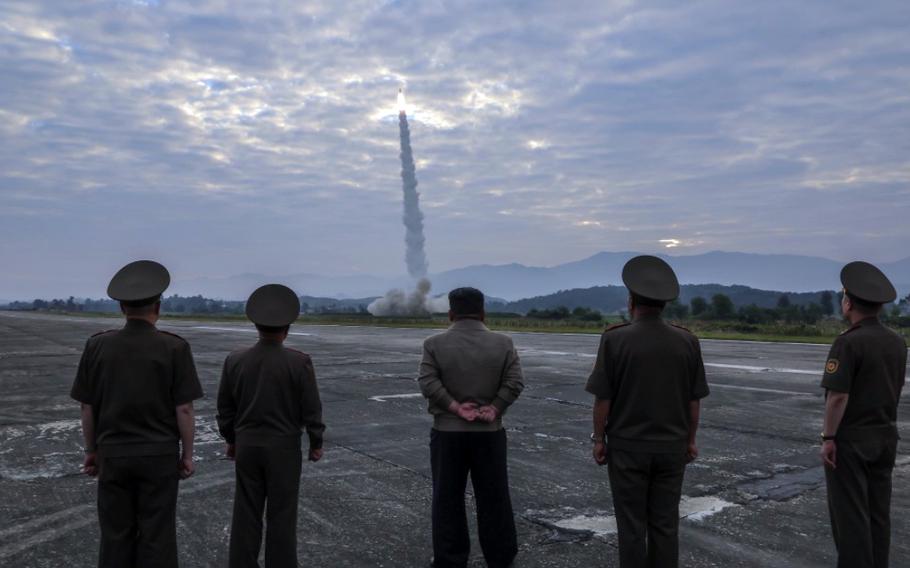
North Korean leader Kim Jong Un, center, and military officials watch at missile launch in this image from the state-run Korean Central News Agency on Sept. 19, 2024. (KCNA)
SEOUL, South Korea — North Korea’s most recent show of force was the successful testing of “highly upgraded” short-range ballistic and strategic cruise missiles, the communist regime announced Thursday.
Wednesday’s launches were overseen by North Korean leader Kim Jong Un, who “expressed great satisfaction” with the Hwasongpho-11-Da ballistic missile capable of carrying a 4.5-ton warhead, according to a state-run Korean Central News Agency report the next day.
The weapon can strike targets up to 200 miles away and boasts the explosive power of a “super-large warhead,” the report said.
Kim also oversaw the test of a “highly upgraded” cruise missile, KCNA reported without providing further details.
Wednesday’s missiles were launched at 6:50 a.m. from South Pyongan province and flew northeast approximately 250 miles, the South Korea’s Joint Chiefs of Staff said in a text message to reporters that morning.
The missiles were assessed to have landed near North Korea’s eastern coast and did not fall within Tokyo’s maritime exclusive economic zone, Japan’s Ministry of Defense said in a news release.
Images released by KCNA on Thursday show a missile in flight and an explosion on land, rather than splashing into the sea.
North Korea unveiled the initial Hwasongpho-11 missile at a military parade in 2018. It has since undergone design changes, including a nearly 5-foot length extension and a warhead weight of an additional 2 tons, according to Yang Uk, a research fellow at the Asan Institute for Policy Studies in Seoul.
There do not appear to be significant changes to the weapon’s design since a previous launch on July 1, he told Stars and Stripes by phone Thursday.
North Korea fired two missiles that day, including a Hwasongpho-11 that flew roughly 370 miles northeast from Hwanghae province, about 65 miles southwest of Pyongyang, according to the South’s military. The other missile flew eastward approximately 75 miles before the South’s military lost track of the projectile, due to its abnormal flight pattern.
KCNA reported Wednesday’s test was successful in “verifying the accuracy” of the Hwasongpho-11 and that it could strike targets 200 miles away.
Kim reportedly said the test “and steady improvement” of similar weapons “are directly related to the grave threat” posed by the situation surrounding the Korean Peninsula.
Photos released Thursday by KCNA showed a missile flying toward a white cross on the ground, apparently marking its target at an undisclosed location.
Yang said the accuracy North Korea touts for the Hwasongpho-11 may not reflect its actual capabilities.
“I don’t believe they can achieve that level of accuracy,” Yang said. “Because it’s a test, they can easily set up some other system that cannot be used in a real-time situation.”
Assessing the missile based on photos alone is difficult and Washington and Seoul are continuing to analyze the weapon, South Korean Joint Chiefs of Staff spokesman Lee Sung-jun said at a news conference Thursday.
There is the “possibility of deception” in North Korea’s reporting of the missile’s capabilities, he added.
The North has fired more than 40 ballistic missiles in 10 separate days of testing so far this year. Several short-range ballistic missiles launched Sept. 12 fell into the Sea of Japan also known as the East Sea, according to the South’s Ministry of National Defense.
The recent spate of launches came two weeks after the United States and South Korea concluded a pair of large-scale military exercises throughout the South. Pyongyang, which describes the drills as a rehearsal of an invasion, warned that the allies’ activities prompted the North to increase production of nuclear weapons, KCNA reported Sept. 9.
“The hostile forces can never evade the heavy responsibility for escalating tension and will have to pay a dear price,” the report said.